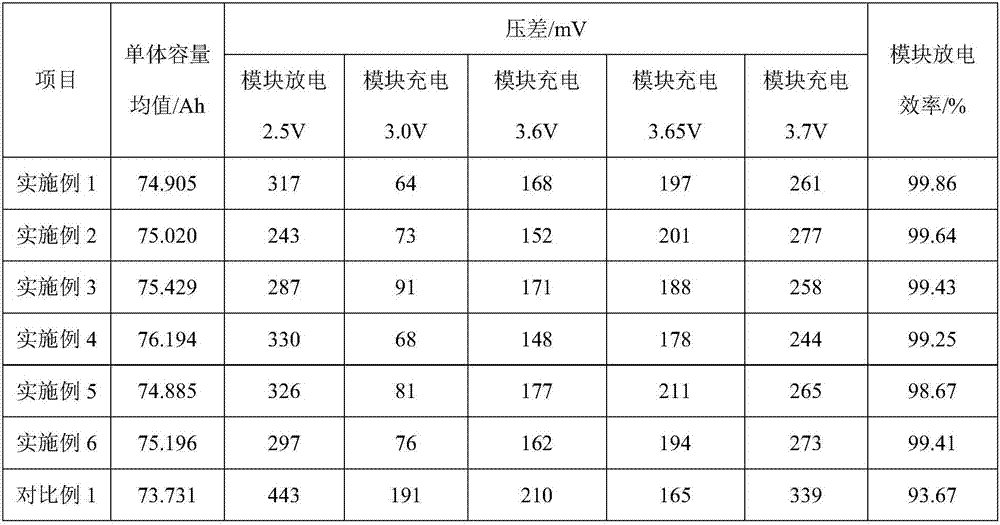Grading method of lithium ion battery
A lithium-ion battery and capacity-division technology, which is applied in the manufacture of secondary batteries, non-aqueous electrolyte batteries, and electrolyte batteries, can solve the problems of inaccurate capacity of lithium-ion batteries and large temperature effects, and achieves short capacity separation time and reduced capacity. Temperature influence, easy to control effect
- Summary
- Abstract
- Description
- Claims
- Application Information
AI Technical Summary
Problems solved by technology
Method used
Image
Examples
Embodiment 1
[0023] The capacity division method of the lithium-ion battery of the present embodiment may further comprise the steps:
[0024] 1) Charge the lithium-ion battery to full charge at 20°C in three stages:
[0025] In the first stage, the lithium-ion battery is charged to 3.65V at a constant current of 0.5C and left for 5 minutes;
[0026] In the second stage, the lithium-ion battery is charged to 3.65V at a constant current of 0.1C and left for 5 minutes;
[0027] In the third stage, the lithium-ion battery is charged to 3.65V at a constant current of 0.05C;
[0028] 2) Discharge the fully charged lithium-ion battery at 20°C:
[0029] Discharge the fully charged lithium-ion battery to 2.5V at a constant current of 0.5C, and record the discharge capacity C 1 , placed for 10min;
[0030] Then discharge to 2.5V with a constant current of 0.1C, and record the discharge capacity C 2 ;
[0031] 3) Calculate the split capacity of the lithium-ion battery:
[0032] Add the discha...
Embodiment 2
[0034] The capacity division method of the lithium-ion battery of the present embodiment may further comprise the steps:
[0035] 1) Charge the lithium-ion battery to full charge at 25°C in three stages:
[0036] In the first stage, charge the lithium-ion battery with a constant current of 1C for 1h and leave it for 1min;
[0037] In the second stage, the lithium-ion battery is charged to 3.65V at a constant current of 0.1C and left for 1min;
[0038] In the third stage, charge the lithium-ion battery with a constant current of 0.05C to 3.65V, and let it stand for 10 minutes;
[0039] 2) Discharge the fully charged lithium-ion battery at 25°C:
[0040] Discharge the fully charged lithium-ion battery to 2.5V at a constant current of 1C, and record the discharge capacity C 1 , placed for 5min;
[0041] Then discharge to 2.5V with a constant current of 0.1C, and record the discharge capacity C 2 ;
[0042] 3) Calculate the split capacity of the lithium-ion battery:
[0043...
Embodiment 3
[0045] The capacity division method of the lithium-ion battery of the present embodiment may further comprise the steps:
[0046] 1) Charge the lithium-ion battery to full charge at 30°C in three stages:
[0047] In the first stage, the lithium-ion battery is charged to 3.65V at a constant current of 0.5C and left for 10 minutes;
[0048] In the second stage, the lithium-ion battery is charged to 3.65V at a constant current of 0.1C and left for 10 minutes;
[0049] In the third stage, charge the lithium-ion battery with a constant current of 0.05C to 3.65V, and let it stand for 1min;
[0050] 2) Discharge the fully charged lithium-ion battery at 30°C:
[0051] Discharge the fully charged lithium-ion battery to 2.5V at a constant current of 0.5C, and record the discharge capacity C 1, place for 1min;
[0052] Then discharge to 2.5V with a constant current of 0.05C, and record the discharge capacity C 2 ;
[0053] 3) Calculate the split capacity of the lithium-ion battery:...
PUM
 Login to View More
Login to View More Abstract
Description
Claims
Application Information
 Login to View More
Login to View More - R&D
- Intellectual Property
- Life Sciences
- Materials
- Tech Scout
- Unparalleled Data Quality
- Higher Quality Content
- 60% Fewer Hallucinations
Browse by: Latest US Patents, China's latest patents, Technical Efficacy Thesaurus, Application Domain, Technology Topic, Popular Technical Reports.
© 2025 PatSnap. All rights reserved.Legal|Privacy policy|Modern Slavery Act Transparency Statement|Sitemap|About US| Contact US: help@patsnap.com


